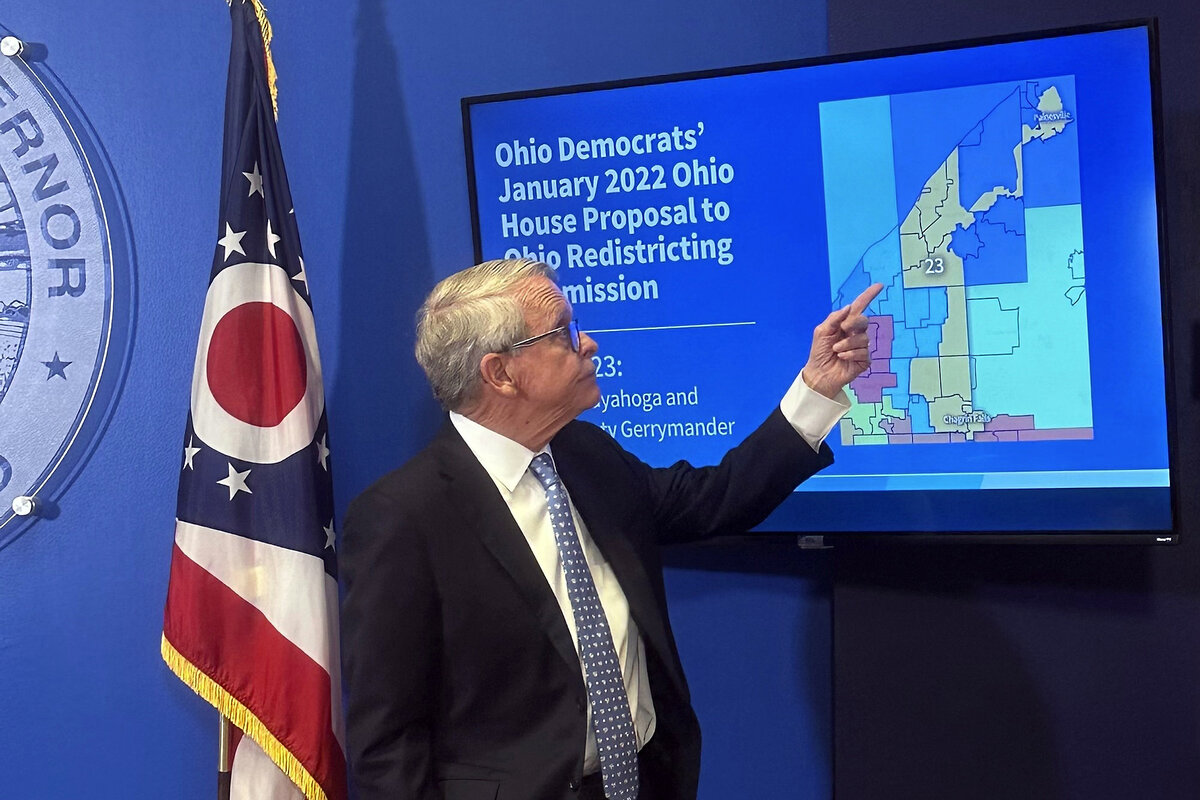On Ohio ballot, a retired justice’s crusade to make politics competitive again
| Columbus, Ohio
When Chief Justice Maureen O’Connor was asked about her retirement plans after 12 years presiding over Ohio’s Supreme Court, she invoked an Italian phrase: dolce far niente – the sweetness of doing nothing.
Instead, a week later she began working on a long-shot ballot proposal that would upend how the state’s political seats are decided. That was January 2023. Now comes the moment of truth.
Republicans who dominate state government have fine-tuned the drawing of boundaries to maximize the number of districts where Democrats have virtually no chance of winning. That has enabled them to deliver veto-proof majorities in the legislature, despite averaging only 54% of votes cast.
Why We Wrote This
One reason compromise has become so hard in politics is that many districts are no longer competitive – and therefore, candidates don’t have to win voters beyond their partisan base. Reforming how districts are drawn is an attempt to fix that.
Ms. O’Connor, a Republican who served as lieutenant governor before being elected to the state’s highest court in 2002, has become a prominent champion for reforming that boundary-drawing process in Ohio. That has pitted her against erstwhile GOP allies.
In November, voters will be asked if they want to loosen politicians’ control over redistricting. The ballot proposal that Ms. O’Connor shaped would empower an independent citizens commission to determine political boundaries.
Only a handful of other states have such a commission. Should the proposal pass, Ohio could become a test case for how a red state weighs the political voice of majority and minority factions. Proponents say a fairer redistricting process led by citizens would boost civic engagement and elevate lawmakers who work across the aisle. However, experts warn that creating more representative districts can be challenging.
The stakes are high for politicians across Ohio’s increasingly polarized political spectrum and for reformers in other states trying to defuse their own redistricting battles.
Her solution for a ‘broken’ system
As chief justice, Ms. O’Connor sided repeatedly with three Democrat justices in 2022 to strike down maps submitted by the state’s GOP-led redistricting commission. The court ruled that the maps for state and federal districts were unconstitutional and ordered the commission to draw representative districts. Three other Republican justices dissented.
The impasse was ended by a federal court ruling that Ohio had to adopt one of the rejected maps for the 2022 cycle.
“The system is broken,” Ms. O’Connor says. “Seven unconstitutional maps prove that.”
Her solution is to put 15 citizens, divided equally among Republicans, Democrats, and independents, in charge, working toward a common goal of producing maps that better reflect voters’ political preferences. Had the politicians on Ohio’s current redistricting commission worked in good faith last time, they might have achieved this goal, she says.
“It all boils down to motivation,” she says.
Undaunted by slings and arrows
Ohio has been here before: In 2015 and 2018, voters overwhelmingly approved constitutional amendments to overhaul its redistricting process and prohibit gerrymandering. But the bipartisan commission that was supposed to reflect public opinion became a battering ram for Republicans seeking to cement a supermajority in the legislature.
Ms. O’Connor says she was always skeptical of the political makeup of the commission, which she calls a “Trojan horse” in the overhaul. In 2021, the two Democrats on the seven-person commission objected to the maps, triggering a review by the state supreme court. That’s when she cast the swing vote with Democratic justices to find the maps unconstitutional.
Her ruling infuriated Republicans; some lawmakers called for her impeachment. The rancor only grew as the court reviewed and rejected multiple GOP-authored maps as partisan gerrymanders. By then, Ms. O’Connor had become convinced that Ohio would be better served by a citizens commission, a view she aired in a concurring opinion from the bench.
Having turned 70, she faced mandatory retirement. When her official portrait was unveiled at the courthouse, two Republican justices didn’t attend, citing scheduling conflicts. She also learned that the state GOP had removed her portrait from its wall. Such snubs don’t trouble her, she insists, since her party affiliation was never tribal, especially when she ruled from the bench.
“People think that I suffered the slings and arrows of all this nastiness and that must have affected me,” she says. “It didn’t.”
Analysts say Ms. O’Connor is a throwback to the moderate type of Midwest Republican who has been largely expunged from a Trump-infused party.
Still, “it’s unusual for a former elected official to be out front on a reform that the Republican Party is generally opposed to,” says Jonathan Entin, a professor emeritus of law at Case Western Reserve University.
He chalks this up to her frustration with the refusal of politicians to heed the court’s redistricting ruling. “I think she’s just been really offended at the way this process played out,” he says.
Most retired justices join big law firms and are amply remunerated. Ms. O’Connor chose a different path as an unpaid campaigner for constitutional reform.
“She’s deeply committed to the public good, the way that she sees it,” says Steven Steinglass, former dean of Cleveland State law school and a friend of Ms. O’Connor, an alum.
Uphill battle for ballot initiative
Ms. O’Connor won’t be voting for the Republican presidential nominee this year. “I’ve never voted for Donald Trump,” she says.
But his name on the ballot will juice turnout and make it harder to pass a constitutional amendment that Republicans in Ohio oppose, says Paul Sracic, a political scientist at Youngstown State University.
It’s also a complex issue, not made easier by the GOP-authored ballot language, which critics called deceptive, but which Ohio’s supreme court let mostly stand.
“The default position of voters is no. If they don’t understand something, they vote no,” he says.
A Founding Father’s role
Gerrymandering is as old as representative democracy. It takes its name from a portmanteau of Founding Father Elbridge Gerry and the salamander-shaped district he created as governor of Massachusetts to break up a stronghold of his Federalist Party rivals.
The map-drawing process, usually based on the census, determines – among other things – how seats are apportioned in the House of Representatives and or state legislatures. When either body is closely divided, strategic mapmakers can flip control to the other party.
“Either party will do anything to gain an advantage,” says Benjamin Schneer, an assistant professor of public policy at the Harvard Kennedy School.
In 2021, Ohio lost a congressional seat, which required a GOP-led redrawing of federal districts, along with new maps for the state legislature to adjust for population change. The ensuing legal battle over both sets of maps cast a national spotlight on Ohio’s hardball politics.
‘This is about power’
But in states such as Colorado, Arizona, and Michigan, where independent bodies draw district lines, the process was less fraught and produced fairer maps that led to competitive races in which candidates usually had to appeal to voters outside their partisan base.
Much depends “on the design of the commissions,” says Professor Schneer, who consulted on Arizona’s commission. But “their maps tend to be less gerrymandered.” It can also dramatically change the makeup of the state legislature.
In Michigan, where voters approved the creation of a citizens commission in 2018, Democrats now hold a statehouse trifecta for the first time in decades. Derrick Clay, a Democratic lobbyist in Columbus, Ohio, says that’s why GOP leaders oppose his state’s ballot measure.
“This is about power, and they don’t want to give up their power,” he says. “The only people who lose out in this scenario are the citizens.”
But opponents argue that a citizens commission, whose members would be appointed by retired judges, wouldn’t be politically accountable.
“If the voters don’t like the way they draw the maps, they can vote them out of office. There is accountability,” says Jane Timken, a former state GOP chair.
Proponents note that such accountability depends, however, on seats being competitive, which isn’t the case in much of Ohio.
The point of an independent redistricting process isn’t to favor one party or another, but to make elections more competitive – and thus more representative.
“All power comes from the citizenry,” says Ms. O’Connor. “And we delegated it to our representative system …That means that they have to reflect what the citizens want.”
















